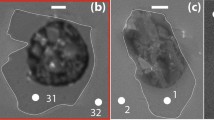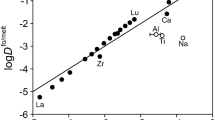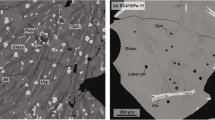Abstract
Rare earth elements are commonly assumed to substitute only for Ca in clinopyroxene because of the similarity of ionic radii for REE3+ and Ca2+ in eightfold coordination. The assumption is valid for Mg-rich clinopyroxenes for which observed mineral/melt partition coefficients are readily predicted by the lattice strain model for substitution onto a single site (e.g., Wood and Blundy 1997). We show that natural Fe-rich pyroxenes in both silica-undersaturated and silica-oversaturated magmatic systems deviate from this behavior. Salites (Mg# 48–59) in phonolites from Tenerife, ferrohedenbergites (Mg# 14.2–16.2) from the rhyolitic Bandelier Tuff, and ferroaugites (Mg# 9.6–32) from the rhyolitic Rattlesnake Tuff have higher heavy REE contents than predicted by single-site substitution. The ionic radius of Fe2+ in sixfold coordination is substantially greater than that of Mg2+; hence, we propose that, in Fe-rich clinopyroxenes, heavy REE are significantly partitioned between eightfold Ca sites and sixfold Fe and Mg sites such that Yb and Lu exist dominantly in sixfold coordination. We also outline a REE-based method of identifying pyroxene/melt pairs in systems with multiple liquid and crystal populations, based upon the assumption that LREE and MREE reside exclusively in eightfold coordination in pyroxene. Contrary to expectations, interpolation of mineral/melt partition coefficient data for heavy REE does not predict the behavior of Y. We speculate that mass fractionation effects play a role in mineral/melt lithophile trace element partitioning that is detectable among pairs of isovalent elements with near-identical radii, such as Y and Ho, Zr and Hf, and Nb and Ta.









Similar content being viewed by others
References
Andújar J, Costa F, Martí J, Wolff JA, Carroll MR (2008) Experimental constraints on pre-eruptive conditions of phonolitic magma from the caldera-forming El Abrigo eruption, Tenerife (Canary Islands). Chem Geol 257:173–191
Bau M (1996) Controls on the fractionation of isovalent trace elements in magmatic and aqueous system: evidence from Y/Ho, Zr/Hf, and lanthanide tetrad effect. Contrib Mineral Petrol 123:323–333
Bau M (1999) Scavenging of dissolved yttrium and rare earths by precipitating iron oxyhydroxide: experimental evidence for Ce oxidation, Y-Ho fractionation, and lanthanide tetrad effect. Geochim Cosmochim Acta 63:67–77
Bau M, Dulski P (1999) Comparing yttrium and rare earths in hydrothermal fluids from the Mid-Atlantic Ridge: implications for Y and REE behaviour during near-vent mixing and for the Y/Ho ratio of Proterozoic seawater. Chem Geol 155:77–90
Bennett SL, Blundy J, Elliott T (2004) The effect of sodium and titanium on crystal-melt partitioning of trace elements. Geochim Cosmochim Acta 68:2335–2347
Blundy J, Wood B (1994) Prediction of crystal-melt partition coefficients from elastic moduli. Nature 372:452–454
Blundy J, Wood B (2003) Partitioning of trace elements between crystals and melts. Earth Planet Sci Lett 210:383–397
Blundy JD, Robinson JAC, Wood BJ (1998) Heavy REE are compatible in clinopyroxene on the spinel lherzolite solidus. Earth Planet Sci Lett 160:493–504
Bottazzi P, Tiepolo M, Vannucci R, Zanetti A, Brumm R, Foley SF, Oberti R (1999) Distinct site preferences for heavy and light REE in amphibole and the prediction of Amph/LDREE. Contrib Mineral Petrol 137:36–45
Brice JC (1975) Some thermodynamic aspects of the growth of strained crystals. J Cryst Growth 28:249–253
Bryan SE (2006) Petrology and geochemistry of the quaternary caldera-forming, phonolitic Granadilla eruption, Tenerife (Canary Islands). J Petrol 47:1557–1589
Cameron M, Papike JJ (1980) Crystal chemistry of silicate pyroxenes. Rev Mineral 7:5–92
Chacko T, Cole DR, Horita J (2001) Equilibrium oxygen, hydrogen and carbon isotope fractionation factors applicable to geologic systems. Rev Mineral Geochem 43:1–81
Collerson KD, Williams Q, Murphy D (2007) Chemical and isotopic heterogeneities in the deep earth; importance of lower mantle carbonate-rich melts. Eos Trans AGU 88: 52 Suppl
Droop GTR (1987) A general equation for estimating Fe3+ concentrations in ferromagnesian silicates and oxides from microprobe analyses, using stoichiometric criteria. Mineral Mag 51:431–435
Edgar C, Wolff JA, Olin PH, Nichols HJ, Pitarri A, Cas RAF, Reiners PW, Spell TL, Martí J (2007) The late quaternary Diego Hernandez formation, Tenerife: a cycle of repeated voluminous explosive phonolitic eruptions. J Volcanol Geotherm Res 160:59–85
Fedele L, Zanetti A, Vincenzo M, Lustrino M, Melluso L, Vannucci R (2009) Clinopyroxene/liquid trace element partitioning in natural trachyte-trachyphonolite systems: insights from Campi Flegrei (southern Italy). Contrib Mineral Petrol (doi:10.1007/s00410-009-0386-5)
Foley SF, Tiepolo M, Vannucci R (2002) Trace element partitioning evidence for growth of early continental crust from amphibolites, not eclogites. Geochim Cosmochim Acta 66:238
Gaetani GA, Grove TL (1995) Partitioning of rare earth elements between clinopyroxene and silicate melt; crystal chemical controls. Geochim Cosmochim Acta 59:1951–1962
Green TH, Pearson NJ (1987) An experimental study of Nb and Ta partitioning between Ti-rich minerals and silicate liquids at high pressure and temperature. Geochim Cosmochim Acta 51:55–62
Hamilton DL, MacKenzie WS (1965) Phase-equilibrium studies in the system NaAlSiO4 (nepheline)—KalSiO4 (kalsilite)—SiO2—H2O. Mineral Mag 34:214–231
Hart SR, Dunn T (1993) Experimental cpx/melt partitioning of 24 trace elements. Contrib Mineral Petrol 113:1–8
Hazen RM, Finger LW (1979) Bulk modulus-volume relationship for cation-anion polyhedra. J Geophys Res 84:6723–6728
Hill E, Wood B, Blundy J (2000) The effect of Ca-Tschermaks component on trace element partitioning between clinopyroxene and silicate melt. Lithos 53:203–215
Horng W, Hess PC (2000) Partition coefficients of Nb and Ta between rutile and anhydrous haplogranite melts. Contrib Mineral Petrol 138:176–185
Huang F, Lundstrom CC, McDonough WF (2006) Effect of the melt structure on trace-element partitioning between clinopyroxene and silicic, alkaline, aluminous melts. Am Mineral 91:1385–1400
Irber W (1999) The lanthanide tetrad effect and its correlation with K/Rb, Eu/Eu*, Sr/Eu, Y/Ho, and Zr/Hf of evolving peraluminous granite suites. Geochim Cosmochim Acta 63:489–508
Jaffe HW (1988) Crystal chemistry and refractivity. Cambridge University Press, Cambridge, pp 118–140
Kuentz DC (1986) The Otowi Member of the Bandelier Tuff; a study of the petrology, petrography, and geochemistry of an explosive silicic eruption, Jemez Mountains, New Mexico. MSc thesis, University of Texas Arlington, USA
Larsen LM (1979) Distribution of REE and other trace elements between phenocrysts and peralkaline undersaturated magmas, exemplified by rocks from the Gardar igneous province, south Greenland. Lithos 12:303–315
Lofgren GE, Huss GR, Wasserburg GJ (2006) An experimental study of trace-element partitioning between Ti-Al-clinopyroxene and melt: equilibrium and kinetic effects including sector zoning. Am Mineral 91:1596–1606
Lundstrom CC, Shaw HF, Ryerson FJ, Williams Q, Gill J (1998) Crystal chemical control of clinopyroxene-melt partitioning in the Di-Ab-An system: implications for elemental fractionations in the depleted mantle. Geochim Cosmochim Acta 62:2849–2862
Mahood GA, Stimac JA (1990) Trace-element partitioning in pantellerites and trachytes. Geochim Cosmochim Acta 54:2275–2276
Marks M, Halama R, Wenzel T, Markl G (2004) Trace element variations in clinopyroxene and amphibole from alkaline to peralkaline syenites and granites: implications for mineral-melt trace-element partitioning. Chem Geol 211:185–215
Martí J, Mitjavila J, Araña V (1994) Stratigraphy, structure and geochronology of the Las Cañadas caldera (Tenerife, Canary Islands). Geol Mag 131:715–727
Min K, Reiners PW, Wolff JA, Mundil R, Winters RL (2006) (U-Th)/He dating of volcanic phenocrysts with high-U, Th inclusions, Bandelier Tuff, New Mexico. Chem Geol 227:223–235
Nash WP, Crecraft HR (1985) Partition coefficients for trace elements in silicic magmas. Geochim Cosmochim Acta 49:2309–2322
Nielsen RL, Beard JS (2000) Magnetite-melt partitioning. Chem Geol 164:21–34
Niu Y (2004) Bulk-rock major and trace element compositions of abyssal peridotites: implications for mantle melting, melt extraction and post-melting processes beneath mid-ocean ridges. J Petrol 45:2423–2458
Niu Y, Hékinian R (1997) Basaltic liquids and harzburgitic residues in the Garrett transform: a case study at fast-spreading ridges. Earth Planet Sci Lett 146:243–258
Oberti R, Vannucci R, Zanetti A, Tiepolo M, Brumm RC (2000) A crystal chemical re-evaluation of amphibole/melt and amphibole/clinopyroxene DTi values in petrogenetic studies. Am Mineral 85:407–419
Olin PH (2007) Magma dynamics of the Diego Hernández Formation, Tenerife, Canary Islands. PhD thesis, Washington State University, USA, 416 pp
Perterman M, Hirschmann MM (2002) Trace element partitioning between vacancy-rich clinopyroxene and silicate melts. Am Mineral 87:1365–1376
Poldervaart A, Hess HH (1951) Pyroxenes in the crystallization of basaltic magma. J Geol 59:472–489
Prowatke S, Klemme S (2005) Effect of melt composition on the partitioning of trace elements between titanite and silicate melt. Geochim Cosmochim Acta 69:695–709
Robinson P (1980) The composition space of terrestrial pyroxenes—internal and external limits. Rev Mineral 7:419–494
Rudnick RL, McDonough WF, Chappell BW (1993) Carbonatite metasomatism in the northern Tanzanian mantle; petrographic and geochemical characteristics. Earth Planet Sci Lett 114:463–475
Schosnig M, Hoffer E (1998) Compositional dependence of REE partitioning between diopside and melt at 1 atmosphere. Contrib Mineral Petrol 133:205–216
Shannon RD (1976) Revised effective ionic radii and systematic studies of interatomic distances in halides and chalcogenides. Acta Crystallogr A 32:751–767
Shannon RD, Fischer RX (2006) Empirical electronic polarizabilities in oxides, hydroxides, oxyfluorides, and oxychlorides. Phys Rev B 73:235111
Sisson TW (1991) Pyroxene-high silica rhyolites trace element partition coefficients measured by ion microprobe. Geochim Cosmochim Acta 55:1575–1585
Sowerby JR, Keppler H (1999) Water speciation in rhyolitic melt determined by in-situ infrared spectroscopy. Am Mineral 84:1843–1849
Spell TL, Kyle PR, Thirwall MF, Campbell AR (1990) Nd, Sr, and O isotopic geochemistry of postcollapse rhyolites in the Valles Caldera, New Mexico. Eos Trans AGU 71:1676
Stimac J, Hickmott D (1994) Trace-element partition coefficients for ilmenite, orthopyroxene and pyrrhotite in rhyolite determined by micro-PIXE analysis. Chem Geol 117:313–330
Streck MJ, Grunder AL (1997) Compositional gradients and gaps in high-silica rhyolites of the Rattlesnake Tuff, Oregon. J Petrol 38:133–163
Streck MJ, Grunder AL (2007) Phenocryst-poor rhyolites of bimodal, tholeiitic provinces: the Rattlesnake Tuff and implications for mush extraction models. Bull Volcanol 70:385–401
Thompson RN, Morrison MA, Hendry GL, Parry SJ (1984) An assessment of the relative roles of crust and mantle in magma genesis: an elemental approach. Phil Trans R Soc Lond A 310:549–590
Tiepolo M, Oberti R, Vannucci R (2002) Trace-element incorporation in titanite: constraints from experimentally determined solid/liquid partition coefficients. Chem Geol 191:105–119
Tuttle OF, Bowen NL (1958) Origin of granite in the light of experimental studies in the system NaAlSi3O8-KAlSi3O8-SiO2-H2O. Geol Soc Amer Memoir 74
Vannucci R, Bottazzi P, Wulff-Pedersen E, Neumann E-R (1998) Partitioning of REE, Y, Sr, Zr and Ti between clinopyroxene and silicate melts in the mantle under La Palma (Canary Islands): implications for the nature of the metasomatic agents. Earth Planet Sci Lett 158:39–51
Wade J, Wood BJ (2001) The earth’s ‘missing’ Nb may be in the core. Nature 409:75–78
Warshaw CM, Smith RL (1988) Pyroxenes and fayalites in the Bandelier Tuff, New Mexico: temperatures and comparisons with other rhyolites. Am Mineral 73:1025–1037
Wolff JA (1984) Variation in Nb/Ta during differentiation of phonolitic magma, Tenerife, Canary Islands. Geochim Cosmochim Acta 48:1345–1348
Wolff JA, Storey M (1983) The volatile component of some pumice-forming alkaline magmas from the Azores and Canary Islands. Contrib Mineral Petrol 82:66–74
Wolff JA, Ramos FC, Davidson JP (1999) Sr isotope disequilibrium during differentiation of the Bandelier Tuff; constraints on the crystallization of a large rhyolitic magma chamber. Geology 27:495–498
Wood B, Blundy J (1997) A predictive model for rare earth element partitioning between clinopyroxene and anhydrous silicate melt. Contrib Mineral Petrol 129:166–181
Wood B, Blundy J (2001) The effect of cation charge on crystal-melt partitioning of trace elements. Earth Planet Sci Lett 188:59–71
Wood BJ, Blundy JD (2002) The effect of H2O on crystal-melt partitioning of trace elements. Geochim Cosmochim Acta 66:3647–3656
Wood B, Trigila R (2001) Experimental determination of aluminous clinopyroxene-melt partition coefficients for potassic liquids, with application to the evolution of the Roman province potassic magmas. Chem Geol 172:213–223
Wörner G, Beusen JM, Duchateau N, Gijbels R, Schmincke H-U (1983) Trace element abundances and mineral/melt distribution coefficients in phonolites from the Laacher See Volcano (Germany). Contrib Mineral Petrol 84:152–173
Acknowledgments
We would like to acknowledge Charles Knaack and Scott Cornelius of the Washington State University GeoAnalytical Laboratory for their assistance with ICP-MS and electron microprobe data collection. Early discussions with Else-Ragnhild Neumann were instrumental in initiating this study. We also thank Martin Streck for contributing Rattlesnake Tuff pyroxenes and glasses to this study. We thank Roger Nielsen, Cin-Ty Lee and Jon Blundy for their reviews, which resulted in substantial improvements to the paper. Fieldwork on Tenerife was funded by NSF grant EAR-0001013, and in the Jemez Mountains by NSF EAR-9909700.
Author information
Authors and Affiliations
Corresponding author
Additional information
Communicated by J. Blundy.
Electronic supplementary material
Below is the link to the electronic supplementary material.
Rights and permissions
About this article
Cite this article
Olin, P.H., Wolff, J.A. Rare earth and high field strength element partitioning between iron-rich clinopyroxenes and felsic liquids. Contrib Mineral Petrol 160, 761–775 (2010). https://doi.org/10.1007/s00410-010-0506-2
Received:
Accepted:
Published:
Issue Date:
DOI: https://doi.org/10.1007/s00410-010-0506-2




